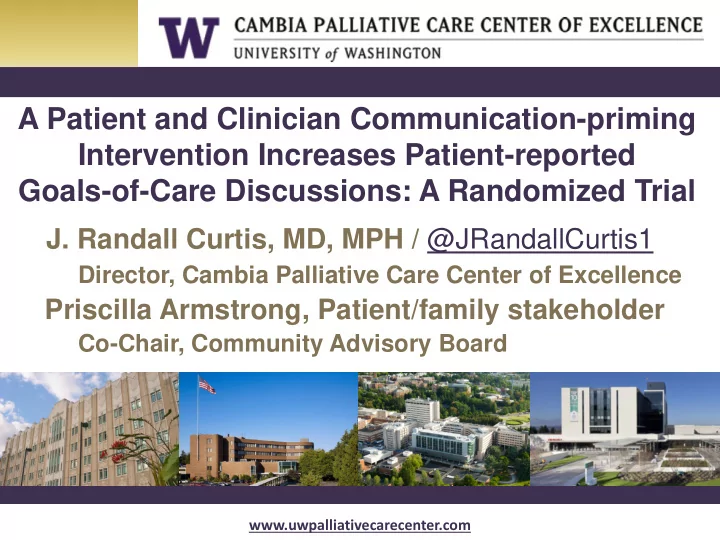

A Patient and Clinician Communication-priming Intervention Increases Patient-reported Goals-of-Care Discussions: A Randomized Trial J. Randall Curtis, MD, MPH / @JRandallCurtis1 Director, Cambia Palliative Care Center of Excellence Priscilla Armstrong, Patient/family stakeholder Co-Chair, Community Advisory Board www.uwpalliativecarecenter.com
Disclosures and Funding • Disclosures – No financial conflict of interest • Funding
J. Randall Curtis, MD, MPH; Lois Downey, MA; Anthony L. Back, MD; Elizabeth L. Nielsen, MPH; Sudiptho Paul; Alexandria Z. Lahdya; Patsy D. Treece, RN, MN; Priscilla Armstrong; Ronald Peck, MBA; Ruth A. Engelberg, PhD Effect of a Patient and Clinician Communication-Priming Intervention on Patient-Reported Goals-of-Care Discussions Between Patients With Serious Illness and Clinicians: A Randomized Clinical Trial Published online May 26, 2018 Available at jama.com and on The JAMA Network Reader at mobile.jamanetwork.com
Terminology: Advance Care Planning and Goals-of-care Discussions • Advance care planning: discussions about values, goals, and preferences for future care Advance Care – Healthy individuals Planning – Chronic illness – Imminently dying • Goals-of-care discussions: discussions about current Goals-of-care goals and how they should Discussions inform current & future care – Chronic illness (early) – Imminently dying (late)
Background • Advance care planning and goals-of- care discussions associated with – Increased quality of care & quality of life – Reduced psychological distress – Reduced intensity of end-of-life care • Frequently do not occur for patients with chronic, serious illness
Research Question • Can a bi-directional, patient-specific communication priming intervention improve goals-of-care discussions with setting? – Bi-directional: patient and clinician – Patient-specific: using surveys from patients to prime and guide discussions Curtis, JAMA Intern Med, 2018 178:930-940
Study Design • Cluster-randomized trial randomizing primary care and specialty clinicians • Two multi-hospital healthcare systems in Seattle • Patient eligibility: chronic illness with median survival of about 2 years • Intervention: Jumpstart-Tips - patient-specific one-page prompt based on patient surveys delivered before a target routine clinic visit • Control: usual care plus surveys • Analyses use intention-to-treat with clustered analyses adjusting for baseline characteristics Curtis, JAMA Intern Med, 2018 178:930-940
CLINICIAN SAMPLE
PATIENT SAMPLE
Outcomes • Occurrence of a goals-of-care discussion – Patient reports by survey at 2 weeks – EHR documentation by clinicians Primary • Patient-assessed quality of communication (QOC) at 2 weeks • Patient-assessed goal-concordant care at 3 months • Patient symptoms of anxiety and depression at 3 and 6 months Curtis, JAMA Intern Med, 2018
27% participation 92% included for primary outcome
59% participation 74% follow-up at 2 weeks 72% follow-up at 3 months 65% follow-up at 6 months
Baseline Characteristics: Clinicians Clinicians % or mean (SD) Racial/ethnic minority 24% Age 47 (9.6) years Female 53% Type Physician 93% Nurse practitioner 7% Specialty General internal medicine 27% Family medicine 23% Oncology 19% Cardiology 13% Pulmonary 6% Curtis, JAMA Intern Med, 2018
Baseline Characteristics: Patients Clinicians % or mean (SD) Racial/ethnic minority 24% Age 47 (9.6) years Female 53% Type Physician 93% Nurse practitioner 7% Specialty General internal medicine 27% Family medicine 23% Oncology 19% Cardiology 13% Pulmonary 6% Curtis, JAMA Intern Med, 2018
Occurrence of a Goals-of-care Discussion at Target Clinic Visit Curtis, JAMA Intern Med, 2018
Quality of Communication at Target Clinic Visit Outcome (scale 0-10) Control Intervention p value 2.1 4.6 0.010 4-item QOC construct Cohen d = 0.56 Items: Talking about… p value control intervention outcome (scale 0 to 10) 1. feelings about getting sicker 6.3 7.7 0.001 2. end-of-life treatments 4.5 6.7 0.001 3. what’s important in life 5.6 7.1 0.002 4. details of getting sicker 5.9 6.9 0.12 5. how long you might live 3.4 4.0 0.10 6. what dying might be like 2.1 2.2 0.35 7. spirituality and religion 2.4 3.1 0.08 Curtis, JAMA Intern Med, 2018
Patient-reported Goal-concordant Care • Validated 2 items from SUPPORT 1. “If you had to make a choice at this time, would you prefer a plan of care focusing on: A. extending life as much as possible, even if it means having more pain and discomfort, or B. relieving pain and discomfort as much as possible, even if that means not living as long?” 2. “What is the focus of your current care?” (same 2 options) • Concordance defined as a match Curtis, JAMA Intern Med, 2018
Patient-reported Goal-concordant Care at 3 months Curtis, JAMA Intern Med, 2018
Symptoms of Anxiety and Depression at 3 and 6 months • Assessed with PHQ-8 and GAD-7 • No differences – Composite scores for PHQ-8 and GAD-7 – Two-item latent indicators • PHQ-2 and GAD-2 – Any individual item (n=15) on either PHQ-8 or GAD-7 Curtis, JAMA Intern Med, 2018
Conclusions: Effects of Jumpstart-Tips • Increased occurrence and quality of goals- of-care discussions − Patient report and EHR documentation • Increased patient-reported goal-concordant care among patients with stable goals • No change in symptoms of anxiety and depression • May represent a useful intervention for healthcare systems interested in increasing early goals-of-care discussions http://www.uwpalliativecarecenter.com @JRandallCurtis1
Two Primary Forms of Stakeholder Input 1. Community Advisory Board - Cambia Palliative Care Center of Excellence – Chairs: P. Armstrong and R. Peck – 20-25 members meet quarterly – Diverse group: patients, family members, patient advocates, organizational representatives 2. Qualitative interviews – Patients, family members, clinicians
Stakeholder Input: Value Added CAB Qualitative interviews • Supported value of Jumpstart • Focused outcomes on intervention patient-centeredness − Prompted better discussions • Revised religiosity to focus − Primed patients for discussion on spirituality • Suggested simplifying the • Simplified surveys Jumpstart form • Improved educational • Identified importance of videos reassessing goals and • Improved recruitment preferences due to changes − Re-framed approach to over time focus more on altruism • Supported family − Supported broadening involvement, but also eligibility criteria highlighted difficulties of recruiting family
Curtis, JAMA Intern Med, 2018 178:930-940
Recommend
More recommend